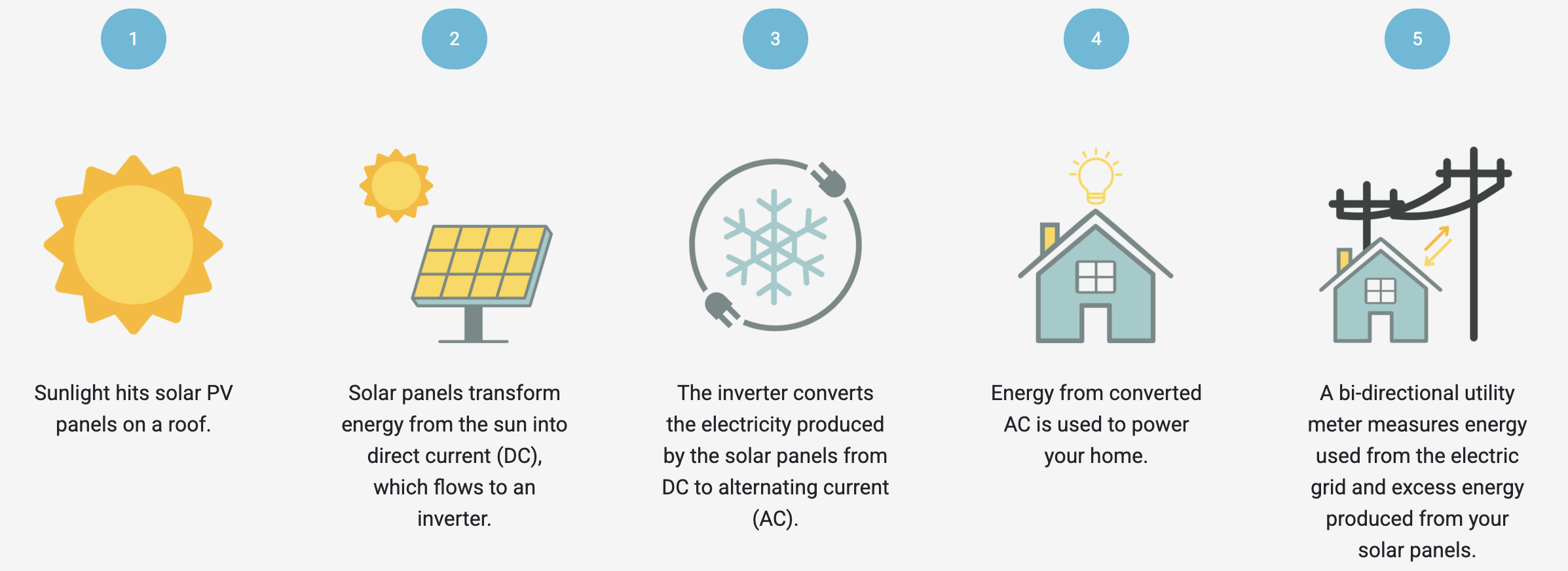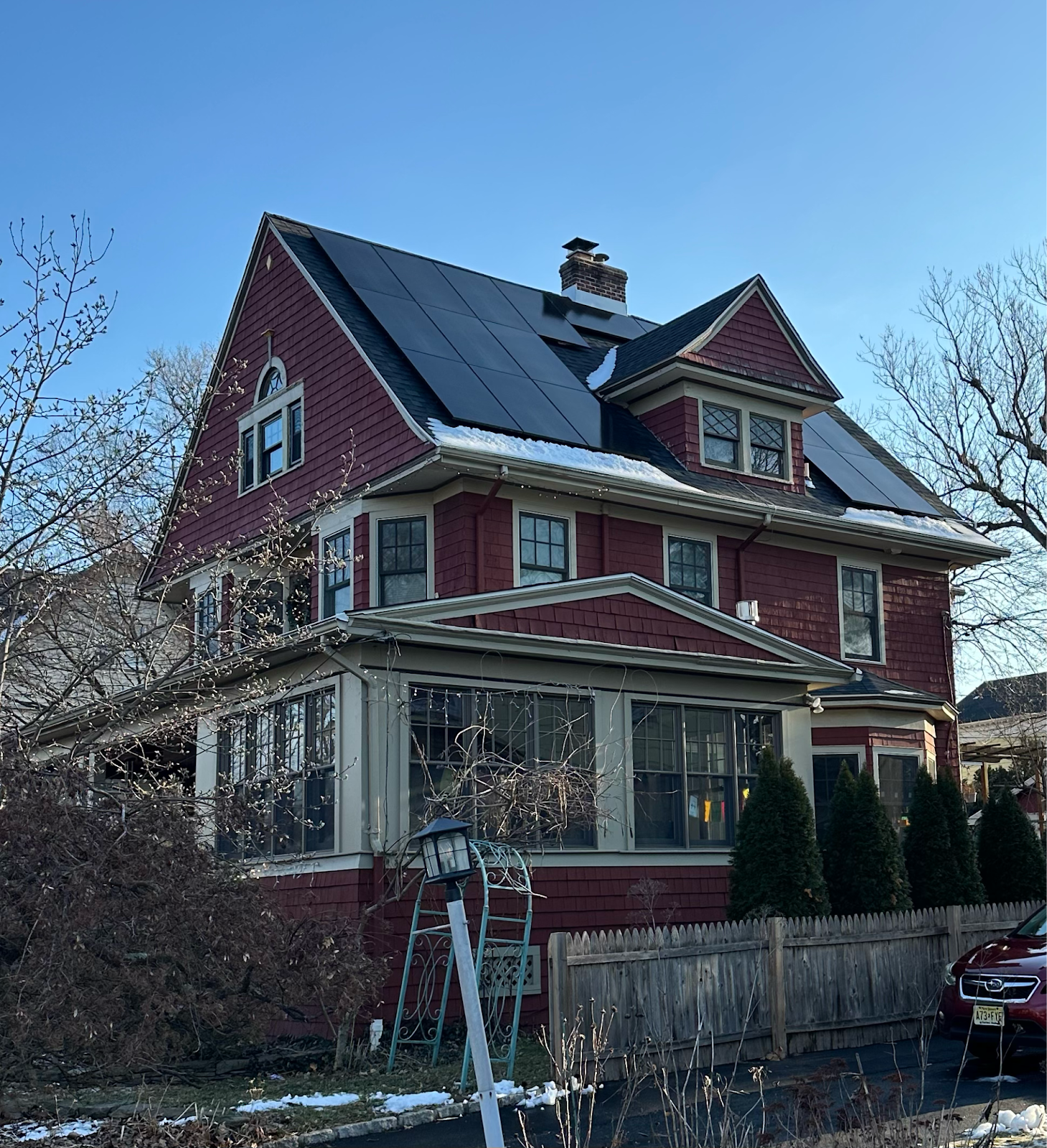Installing rooftop solar can help homeowners save on electricity bills over time and provide greater energy resilience — as well as helping combat climate change. Thanks to sharp declines in the cost of panels, and government incentives, getting solar now makes financial sense for many homeowners. If you don’t have these on your roof yet, there is no better time to look into it!
Actions you can take right now:
- Find out whether your house is suitable for rooftop solar, and how much energy it can produce. Get started by looking at your address at Project Sunroof to assess your solar potential.
- If your home is not suitable for your own solar panels or you live in a condo or rental, consider a Community Solar subscription.
- EnergySage can compile estimates for you and provide a consultant to guide you through the process of selecting a contractor - all for free!
- Alternatively, get multiple estimates from solar contractors. Carefully consider factors such as how large the proposed system is, and how much energy it can realistically generate based on roof pitch, direction, and shade.
How can solar reduce emissions?
Solar panels convert sunlight into electricity without emitting carbon dioxide or other greenhouse gases. Electricity generated by the sun replaces electricity generated from sources such as natural gas, curtailing your home’s emissions. Using solar electricity to power electrified appliances that may have otherwise used natural gas (e.g. electric stoves, washer/dryers, heat Pump HVAC, heat pump water heaters, etc.) creates a much greener home. Solar panels can also immediately start lowering SOMA residents’ monthly electricity bills.
This is why rooftop solar is growing in SOMA. As of November 2024, more than 700 buildings have solar panels mounted on their roofs in our two towns.
How does rooftop solar work?
Rooftop solar panels on residential buildings are typically connected to the electric grid, the network for electricity to be delivered from power plants to end users. New Jersey utility rules allow “net metering” to keep track of the net electricity consumption of customers with rooftop solar. A building uses all the solar energy generated by its solar panels, and sends any excess power to the grid. When electricity needs exceed what the solar system is generating, the building draws energy from the grid. The utility company accounts for the difference between the amount sent to the grid and the amount drawn from the grid. If more electricity is produced by solar than used by the building, that results in a credit for future net usage.

Some homeowners choose to install backup batteries to store excess power generated by their solar panels. They come in handy during power outages, and are cleaner, quieter and much more efficient than gas-powered generators. Typically, battery backup is needed to use the energy from rooftop solar during power outages. This is due to safety concerns during power outages when technicians may be servicing the grid, and therefore cannot have electricity fed in from solar.
How much does rooftop solar cost?
Rooftop solar installation costs vary by several factors, including the size of the installation, and the company you choose. When sizing your system, you will need to consider how much rooftop space you can dedicate to the solar panels, how many hours of sunlight your roof gets, and your home’s energy needs.
Although the upfront investment may be significant, your system may pay for itself in just a matter of years.
In addition to buying solar systems outright, some homeowners choose to finance their system. Another option is to sign a Power Purchase Agreement (PPA) often referred to as rooftop leasing. Under a PPA, customers agree to host a solar system on their rooftop and to purchase the energy generated by the solar system under a long-term contract. Remember to consult multiple providers and read the terms of any agreements closely.
Read about each financing approach’s pros and cons here and here.
What do I need to consider before installing rooftop solar?
How suitable is your roof for solar?
Shade, roof pitch, and direction are all key factors. Try Google’s Sunroof or a similar website to find out your roof’s solar potential. Obtain quotes from multiple solar providers and ask questions about how much energy their proposed systems can realistically produce. You’ll need to consider how much energy your rooftop system can produce relative to its cost as well as your family’s needs. In some cases, this can be a difficult decision. Your roof may be in a “gray area”, where its production potential is limited, but will still save you money on your utility bills while producing clean energy.
| Question to ask | Where to get this info | Example | What does this number mean? | |
|---|---|---|---|---|
| How much electricity do you use per day? | On your PSE&G electric bill under “Average Daily Usage”. | 25 kWh per day in Winter 45 kWh per day in Summer | 1 kWh = Using 1000 Watts of power for 1 hour. Examples of appliances that are on continuously: •8W: LED light bulb •70W: LED TV •600W: Window A/C •3000W (3kW): Central A/C | |
| What size system can my roof accommodate? | Quotes from solar contractors | 7kW system | The total capacity of the solar panels rated by the manufacturer is 7kW. This is considered an average-sized system. | |
| How much electricity can my roof realistically generate with Solar? | Discussion with solar contractors, recommendations from SOMA neighbors with solar | A range of 10 kWh per day in Winter, to 30 kWh per day in Summer | These are estimates that depend on many factors such as roof pitch, roof direction, and shade from trees and other buildings. In this example, the home’s usage is 40% offset by solar in Winter. In summer, it is 67% offset. This translates to savings on your electric bill! |
How old is your roof?
If your roof is nearing the end of its life, a roof replacement will be necessary before installing solar. Some solar installers may offer roof replacements as well.
Can your electrical panel handle it?
Consult an electrician to ensure your electrical panel has the capacity to handle the input from your rooftop solar installation. Upgrading your electrical panel might be necessary, especially if you are planning other electrification projects in your home.
Is battery backup desirable?
You may choose to install battery backup if you want no interruptions during power outages, or if you want to use more of the electricity your solar panels produce when the sun is down.
What if my roof is unsuitable for solar? Or if I live in a condo or a rental property?
Some roofs are unsuitable for solar panels – due to shade from trees or other buildings, or the roof’s size or orientation. For people in this situation, joining a Community Solar project can be a good alternative. Community Solar customers can “subscribe” to a portion of a commercial solar installation and receive a credit on their electricity bill for the electricity generated by their share of the generation. In most cases, the subscription is considerably cheaper than regular utility rates. If the subscribed portion of the solar project produces more energy than you use, you can choose to bank the excess power.
Since the subscription funds the development of the solar project, community solar is an excellent way to encourage and help finance solar. Find a project near you on the New Jersey Solar Project Finder.
What incentives are available?
Federal (Expires Dec 31, 2025)
A tax credit of 30% of the total improvement expenses in the year of installation, the Residential Clean Energy Credit, is available until December 31, 2025.
New Jersey
New Jersey’s Clean Energy Program offers these additional incentives for rooftop solar:
New Jersey Solar Renewable Energy Certificate 2 Program: Owners of residential systems currently are eligible for 8.5 cents per kilowatt-hour ($85/ megawatt-hour) generated under the Solar Renewable Energy Certificate (SREC-II) program. Homeowners registered with the program are awarded one SREC for every 1,000 kilowatt hours of electricity their solar system generates over the first 15 years of operation. Combined with net metering, each kilowatt hour generated is worth about 30 cents per kilowatt-hour through free electricity and SREC-II incentives. With a PPA/lease arrangement the system owner, not the resident, receives these benefits.
Solar Sales Tax Exemption offers a full exemption from the state’s sales tax for all solar energy equipment purchased outright. This exemption is available to all taxpayers.
New Jersey also provides a local property tax deduction for the value of renewable energy systems used to meet on-site electricity, heating, cooling, or general energy needs.
Where can I find solar installers?
The New Jersey Board of Public Utilities provides a list of certified solar installers and vendors.
EnergySage is an online solar marketplace that allows homeowners to receive and compare multiple quotes for rooftop solar panels from vetted installers in your area.
